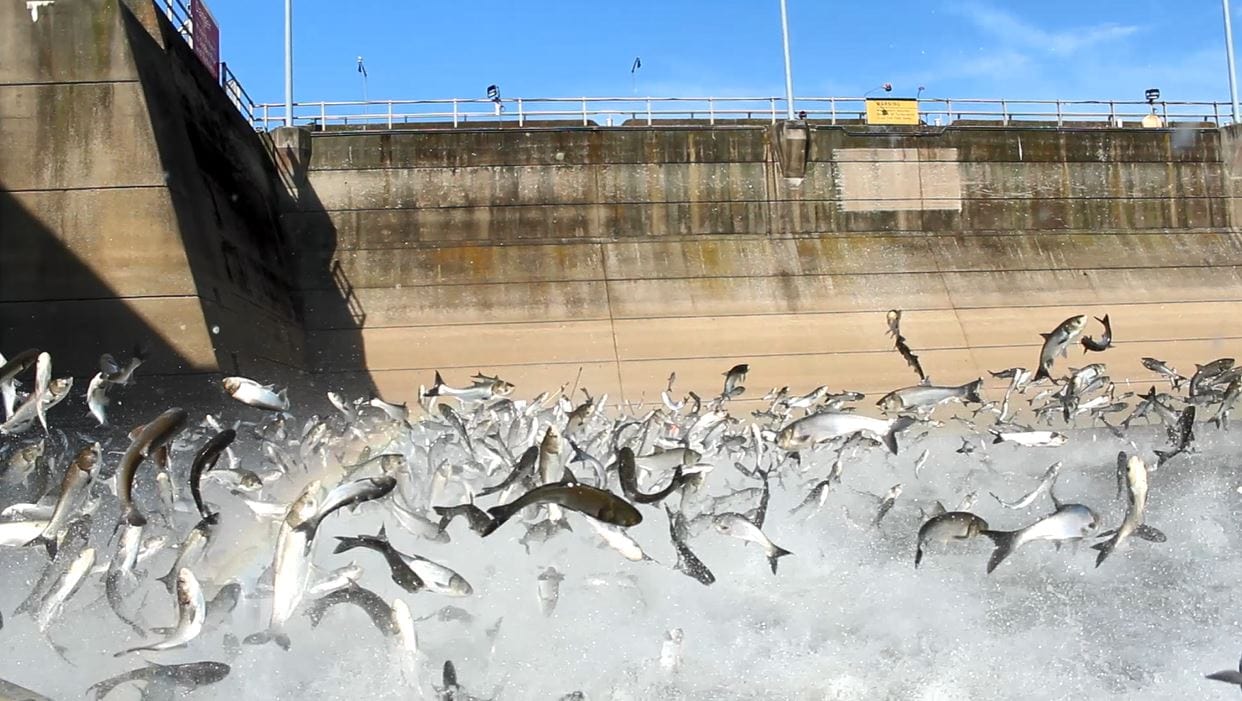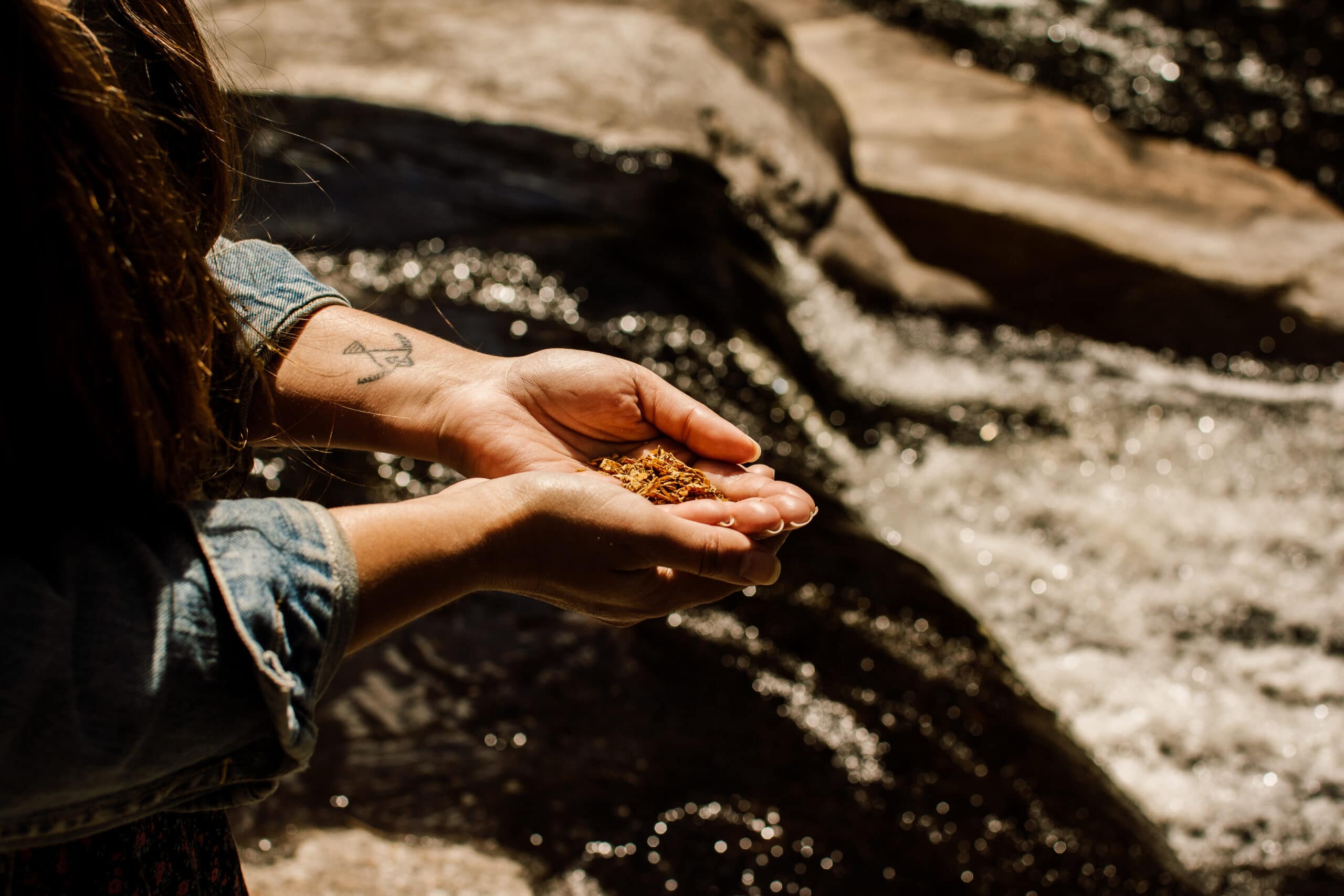Fish espionage for Great Lakes defense

Silver carp are easily spooked out of the water by the noise from passing boats. These ~40 kilogram carp can leap up to 3 metres into the air! Photo by The Invasive Carp Regional Coordinating Committee (Flickr: Link)

These carp are part of an electrofishing study, a common scientific survey method that is safe for aquatic life. The shocked fish will typically regain normal mobility within two minutes. Photo by The Invasive Carp Regional Coordinating Committee (Flickr: Link)
Over the past decade, the Asian carp has been a growing threat throughout the Great Lakes- St. Lawrence watershed for their ability to out-compete native species. While all four species of invasive Asian carp — bighead, black, grass, silver — have had recent sightings in tributaries of the Great Lakes, none are believed to have established populations in any of the Great Lakes — yet. These sightings have spurred efforts to block the fish from entering the Great Lakes from the Mississippi via the Chicago Area Waterway System — the most likely path of invasion.
Enter fish espionage. Wildlife officials across the watershed are using acoustic telemetry to turn unwitting carp into spies for environmental monitoring. Scientists catch the traitor and surgically implant or externally attach a tag — consisting of a battery, microchip, and transducer — onto the carp before releasing it back into the waters. Then, the secret agent’s work begins.
In the spring and fall, Asian carp gather in large schools, where the spy eventually swims to meet up with their fish friends. Receivers track their location and help scientists gather data about where and when these fish go — and what kind of behaviours they are exhibiting. This allows governments to better make predictions of Asian carp populations, ensuring they are making data-based policies and defenses to slow the carp’s advance.
Scientists also sometimes recruit traitors for the acoustic telemetry “seek-and-destroy” method. They collect the data, then eliminate the schools altogether, further preventing breeding, movement and ultimately reducing the chances of infiltration into the Great Lakes.
Running out of air
It’s that time of year again when we all dread slippery sidewalks and black-ice-covered roads. But road salt — the ubiquitous solution to these icy woes — is damaging the health of urban waterways by depleting their oxygen levels.
The salt we spread on our roads, sidewalks and parking lots is washing into rivers and lakes — and even further into aquifers. Not only does this impact the quality of drinking water, but also the biodiversity of local waterways, according to University of Waterloo researcher Philippe Van Cappellen.

Road salt makes winter roads safer to drive, but at a cost to the environment. Photo by Pexels (Pixabay: Link)
As salt concentrations increase in water due to road runoff, so does the water’s density. This inhibits the seasonal mixing of the water that occurs as surface water temperatures change. Without this mixing, the oxygen levels in deeper areas of the lake are quickly depleted and nutrients remain settled at the bottom of the lake. The lack of oxygen limits the areas of the lake that can support aquatic animals such as fish.
Van Cappellen says municipalities need to be discussing their road salt use, and find concrete ways to reduce it sooner rather than later. “It’s not something that can wait for another 10 years or 20,” he says. “I think it should be an ongoing process.”
Many solutions have been developed to try to address the problems caused by road salt use including brines, beet juice, and cheese byproducts, but the most effective method so far, say researchers, is the strategic application of salt.
For more information, read The price of salt: How road salts are affecting our Great Lakes.
Two-eyed collaboration on TAP for Great Lakes restoration

“Western and Indigenous approaches to science need each other to be a whole knowledge system.” Photo by Alyssa Bardy
First Nations, Tribal and Métis governments should be active and equal partners to the US and Canada in the Great Lakes Water Quality Agreement review process, according to the 2023 International Joint Commission’s (IJC) Third Assessment of Progress (TAP) report on Great Lakes Water Quality which was released on November 9. It summarized three major recommendations for achieving a healthier future for the Great Lakes.
Indigenous Peoples of the Great Lakes have shared a strong kinship with the waters since time immemorial. The many spoken languages among the many peoples were shaped by the same elements that created the escarpments and basins of the region over millennia.
The IJC report recommends the US and Canadian federal governments work with the Nations and Tribes to develop a basinwide climate resiliency goal and to continue to incorporate Traditional Ecological Knowledge into their 10-year Great Lakes science plan. The TAP report also recognizes the importance of the continued incorporation of cultural perspectives in addressing water quality issues within the Great Lakes.
“Knowledge is powerful only if it’s shared, and in my experience Western and Indigenous approaches to science need each other to be a whole knowledge system,” says IJC Commissioner Henry Lickers, of Seneca Nation, Turtle Clan. “By continuing to empower and include Indigenous Peoples in the shaping and implementation of the Agreement over its next 50 years, we all stand to benefit.”
Line 5 tunnel project a step closer to breaking ground

A shot of the Mackinac Bridge in the Straits of Mackinac. Photo by GEGodby (Pixabay: Link)
Regulators in Michigan recently approved a key permit that will enable Enbridge to break ground on the Line 5 petroleum tunnel beneath the Straits of Mackinac after three years of deliberations. The degrading pipelines that currently span the water between Michigan and Lake Huron were built in 1953. The ruling by the Michigan Public Service Commission granted permission to Enbridge to re-route a 6.4-kilometre section of the 1040-kilometre petroleum pipeline into a concrete tunnel once construction of the tunnel is completed.
Enbridge spokesperson Ryan Duffy said this approval was “a major step forward in making the Great Lakes Tunnel Project a reality, protecting the Great Lakes and securing the vital energy people in Michigan and surrounding region rely on every day. ”
However, Native American Tribes in Michigan, as well as environmentalist groups, oppose the decision, as they say it violates their treaty rights and that the approval is out of step with recommendations of leading climate scientists. All of the federally recognized Tribes in the state of Michigan have passed resolutions opposing the pipeline.
“For decades [Enbridge] have incorrectly asserted they are above law and regulation,” says Whitney Gravelle, President of the Bay Mills Indian Community. “Their disregard of the rights of Tribal Nations is part of a long history by Enbridge of putting profit above anything else — a history that must finally come to an end.”
The Oil and Water Don’t Mix Coalition, a clean water action group in Michigan, also opposes the Line 5 petroleum pipeline construction, stating its record of past spills — 33 spills and about 1.1 million gallons along its length since 1968 — as a major cause for concern. They also raise their concerns over how long the construction process will take while not addressing the severe threats the current Line 5 pipeline already poses on the freshwater basin.



